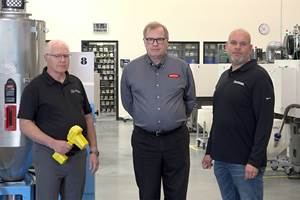Mobile-Drying Project Required ‘In-the-Box’ Thinking
Portable material drying by truck is the concept behind an initiative launched last month by Poly Clean USA LLC, Charleston, S.C., with Dri-Air Industries.
Portable material drying from a truck? That’s precisely the concept behind an initiative launched last month by Poly Clean USA LLC, Charleston, S.C. The novel venture is a spinoff of a somewhat related operation Poly Clean started in 1999: a five-truck “factory on wheels” fleet that brings various optical-sorting technologies right to processors, resin companies, recyclers, and compounders, allowing them to eliminate off-spec material without a single pound of resin ever leaving their plant.
The drying venture is aimed at processors and resin suppliers/compounders who are dealing with either seasonal or year-round problems with moisture, says Mark Richards, who co-owns Poly Clean. These clients may even have their own drying capacity—just not enough. “We go to plants where material is out of spec and help get it ready for processing,” says Richards.
Poly Clean worked with Dri-Air Industries, E. Windsor, Conn., to bring this project to fruition. “We needed someone who was willing to think ‘inside the box,’” says Richards, referring to the 8 ft wide x 9 ft tall x 28 ft long truck. Richards says Poly Clean has already signed up a client for the drying service—a 7 million lb/yr project—and has several others in the wings. He expects to expand the service beyond one truck as business dictates.
“The task we were given was to dry up to 1000 lb/hr of resin with a 6-hr residence time,” recalls Charles Sears, Dri-Air president. “Normally, this would be easy with a 1000-cfm dryer and 6000-lb capacity hopper on a stand outfitted with an appropriate hopper loader. But we somehow had to figure out how to mount all of the equipment in a truck that would not require a Class 2 license to drive,” says Sears. “So a trailer was out of the question. Obviously, standard equipment does not fit into a truck, as a 6000-lb capacity hopper is taller than a truck.”
Dri-Air’s design incorporated six modified 1000-lb capacity hoppers that each process 166 lb/hr. The six hoppers were divided into two banks of three hoppers, with a 500-cfm dryer for each hopper bank. As a safeguard in case the 6-hr residence time was insufficient, Dri-Air added its portable HPD-13 dryer, fed from the six drying hoppers, to act as a “finishing” hopper.
To fit within the truck’s height limits, the hopper cone was shortened and a take-off box with quick-clamp access was added. Low-profile, high-capacity receivers on top of each hopper left a 2-in. clearance to the top of the truck. Minor changes to the dryer allows access to all filters and servicing once in the truck.
Three loading systems were used. The first loads all six hoppers from material outside the truck. A 10-hp positive-displacement pump with a 2.5-in. common material line fills the six hoppers in rotation. The system is sized to load all six hoppers in less than an hour. After that, the dryers can be started as part of the 6-hr cycle.
Once dried, the material is closed-loop conveyed to the seventh hopper on the HPD-13 dryer. To meet the required throughput rate, two receivers are used on that hopper. While one receiver is loading, the other is dumping material into the hopper for a continuous loading cycle. After filling the seventh hopper, both conveying lines are purged of material to maintain dry material.
The dried material is then conveyed from the seventh hopper to a remote receiver using the 10-hp pump. The receiver can be mounted over the customer’s gaylord or similar container. Because the material in the hopper is fully dried, off-loading can be done either in batches or continuously.
Each hopper has its own heater for accurate temperature control. Temperatures are controlled by the master Unitronics PLC that also monitors and controls loading functions. For throughputs less than 1000 lb/hr, any number of hoppers can be used to maintain the proper residence time for that particular resin. Automatic air valves control the dry air flow to each hopper as they are turned on and off.
Related Content
PiovanGroup Rebrands, with Mostly Minor Name Changes
For the most part, subsidiary company names will remain, with slight modifications meant to enhance the Group’s identity.
Read MoreConair Names New Execs in Sales, Systems, Product Management and Extrusion
Moves aimed at strengthening customer focus, market awareness, and technical expertise in key areas of our business.
Read MoreHow to Effectively Reduce Costs with Smart Auxiliaries Technology
As drying, blending and conveying technologies grow more sophisticated, they offer processors great opportunities to reduce cost through better energy efficiency, smaller equipment footprints, reduced scrap and quicker changeovers. Increased throughput and better utilization of primary processing equipment and manpower are the results.
Read MoreCaptive Molder Beefs Up Auxiliaries to Boost Quality, Consistency
SeeScan adds conveying, drying, feeding and chilling technologies to improve quality — and enhance employee safety — in production of its underground/underwater inspection systems.
Read MoreRead Next
Recycling Partners Collaborate to Eliminate Production Scrap Waste at NPE2024
A collaboration between show organizer PLASTICS, recycler CPR and size reduction experts WEIMA and Conair will seek to recover and recycle 100% of the parts produced at the show.
Read MoreFor PLASTICS' CEO Seaholm, NPE to Shine Light on Sustainability Successes
With advocacy, communication and sustainability as three main pillars, Seaholm leads a trade association to NPE that ‘is more active today than we have ever been.’
Read MoreMaking the Circular Economy a Reality
Driven by brand owner demands and new worldwide legislation, the entire supply chain is working toward the shift to circularity, with some evidence the circular economy has already begun.
Read More











